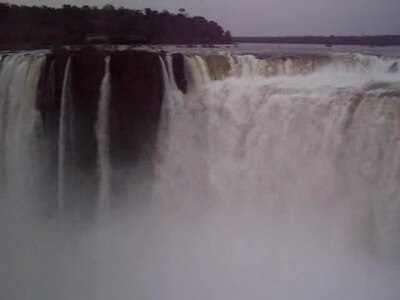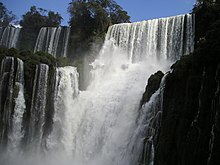The name "Iguazu" comes from the Guarani or Tupi words "y" [ɨ], meaning "water", and "ûasú "[waˈsu], meaning "big".[2] Legend has it that a god planned to marry a beautiful woman named Naipí, who fled with her mortal lover Tarobá in a canoe. In rage, the god sliced the river, creating the waterfalls and condemning the lovers to an eternal fall.[2] The first European to find the falls was the Spanish conquistador Álvar Núñez Cabeza de Vaca in 1541.
Contents
Geography
Iguazu Falls is located where the Iguazu River tumbles over the edge of the Paraná Plateau, 23 kilometres (14 mi) upriver from the Iguazu's confluence with the Paraná River.[1] Numerous islands along the 2.7-kilometre-long (1.7 mi) edge divide the falls into numerous separate waterfalls and cataracts, varying between 60 to 82 metres (197 to 269 ft) high. The number of these smaller waterfalls fluctuates from 150 to 300, depending on the water level.[3] About half of the river's flow falls into a long and narrow chasm called the Devil's Throat (Garganta del Diablo in Spanish or Garganta do Diabo in Portuguese).[1] The Devil's Throat is U-shaped, 82 metres high, 150 m wide, and 700 m long (269×492×2,297 ft). Placenames have been given also to many other smaller falls, such as San Martín Falls, Bossetti Falls and many others.[3]About 900 metres (2,950 ft) of the 2.7-kilometre (1.7 mi) length does not have water flowing over it. The edge of the basalt cap recedes by 3 mm (0.1 in) per year. The water of the lower Iguazu collects in a canyon that drains into the Paraná River, a short distance downstream from the Itaipu Dam. The junction of the water flows marks the border between Brazil, Argentina, and Paraguay. There are points in the cities of Foz do Iguaçu, Brazil, Puerto Iguazú, Argentina, and Ciudad del Este, Paraguay, which have access to the Iguazu River, where the borders of all three nations can be seen, a popular tourist attraction for visitors to the three cities.
Distribution of the Falls between Argentina and Brazil
The Iguazu Falls are arranged in a way that seems like a reverse letter "J". The border between Brazil and Argentina runs through the Devil's Throat. On the right bank is the Brazilian territory, which has just over 20% of the jumps of these falls, and the left side jumps are Argentine, which make up almost 80% of the falls.Tourism
There are two international airports close to Iguazú Falls: the Argentine Cataratas del Iguazú International Airport (IGR) and the Brazilian Foz do Iguaçu International Airport (IGU). Argentina's airport is 25 kilometres (16 mi) from the city of Iguazu but closer to the Falls hotels than its Brazilian counterpart. There is bus and taxi service from and to the Airport-Falls. Brazil's airport is between Foz do Iguaçu, Brazil and the falls. LAN Airlines and Aerolíneas Argentinas have direct flights from Buenos Aires to Iguazu International Airport Krause. Several Brazilian airlines, such as TAM Airlines, GOL, Azul, WebJet, offer service from the main Brazilian cities to Foz do Iguaçu.Access
The falls can be reached from the two main towns on either side of the falls: Puerto Iguazú in Argentina and Foz do Iguaçu in Brazil, as well as from Ciudad del Este, Paraguay, on the other side of the Paraná river from Foz do Iguaçu. The falls are shared by the Iguazú National Park (Argentina) and Iguaçu National Park (Brazil). The two parks were designated UNESCO World Heritage Sites in 1984 and 1987, respectively.[4]The first proposal for a Brazilian national park aimed at providing a pristine environment to "future generations", just as "it had been created by God" and endowed with "all possible preservation, from the beautiful to the sublime, from the picturesque to the awesome" and "an unmatched flora" located in the "magnificent Iguaçú waterfalls". These were the words used by André Rebouças, an engineer, in his book "Provinces of Paraná, Railways to Mato Grosso and Bolivia", which started up the campaign aimed at preserving the Iguaçu Falls in 1876, when Yellowstone National Park, the first national park in the world, was four years old.
On the Brazilian side, there is a walkway along the canyon with an extension to the lower base of the Devil's Throat. Helicopter rides offering aerial views of the falls have been available. However, Argentina has prohibited such helicopter tours because of the environmental impact on the flora and fauna of the falls.[5] From Foz do Iguaçu airport, the park can be reached by taxi or bus to entrance of the park. There is an entrance fee to the park on both sides. Free frequent buses have been provided to various points within the park. The town of Foz do Iguaçu is about 20 kilometres (12 mi) away, and the airport is in between the park and the town.
The Argentine access, across the forest, is by a Rainforest Ecological Train very similar to the one in Disney's Animal Kingdom.[citation needed] The train brings visitors to the entrance of Devil's Throat, as well as the upper and lower trails. The Paseo Garganta del Diablo is a 1-kilometre-long (0.6 mi) trail that brings the visitor directly over the falls of the Devil's Throat, the highest and deepest of the falls. Other walkways allow access to the elongated stretch of falls across the forest on the Argentine side and to the boats that connect to San Martin Island. Also on the Argentine side, there have been inflatable boat services that take visitors right under the falls.
The Brazilian transportation system aims at allowing the increase in the number of visitors, while reducing the environmental impact, through the increase in the average number of passengers per vehicle inside the park.[citation needed] The new transportation system has 72-passenger, panoramic-view, double-deck buses. The upper deck is open, which enables visitors a broad view of the flora and fauna during the trip to the Falls. The buses' combustion systems are in compliance with the CONAMA (phase IV) and EURO (phase II) emissions and noise requirements. The reduction in the number of vehicles, of noise levels and speed, is enabling tourists to observe increasing numbers of wild animals along the route.[citation needed] Each bus has had an exclusive paint scheme, representing some of the most common wild animals found in the Iguaçú National Park, including the spotted jaguars, butterflies, raccoons, prego monkeys, coral snakes, toucans, parrots and yellow breasted caimans.
Comparisons to other famous falls
Upon seeing Iguazu, the United States' First Lady Eleanor Roosevelt reportedly exclaimed "Poor Niagara!"[2] (which, at 50 m or 165 feet, are a third shorter). Iguazu is also often compared with Southern Africa's Victoria Falls which separates Zambia and Zimbabwe. Iguazu is wider, but because it is split into about 275 discrete falls and large islands, Victoria is the largest curtain of water in the world, at over 1,600 m (5,249 ft) wide and over 100 m (328 ft) in height (in low flow Victoria is split into five by islands; in high flow it can be uninterrupted). The only wider falls are extremely large rapid-like falls such as the Boyoma Falls.With the flooding of the Guaíra Falls in 1982, Iguazu currently has the second-greatest average annual flow of any waterfall in the world, after Niagara, with an average rate of 1,746 m3/s (61,660 cu ft/s). Its maximum recorded flow was 12,800 m3/s (452,000 cu ft/s).[6] By comparison, the average flow of Niagara Falls is 2,400 m3/s (85,000 cu ft/s), with a maximum recorded flow of 8,300 m3/s (293,000 cu ft/s).[7] The average flow at Victoria Falls is 1,088 m3/s (38,420 cu ft/s), with a maximum recorded flow of 7,100 m3/s (250,000 cu ft/s).[8]
Mist rises between 30 and 150 metres (100 and 490 ft) from Iguazu's Devil's Throat, and over 300 m (984 ft) above Victoria. However, Iguazu affords better views and walkways and its shape allows for spectacular vistas. At one point a person can stand and be surrounded by 260 degrees of waterfalls. The Devil's Throat in Argentina has water pouring into it from three sides. Likewise, because Iguazu is split into many relatively small falls, one can view these a portion at a time. Victoria does not allow this, as it is essentially one waterfall that falls into a canyon and is too immense to appreciate all at once (except from the air).
Climate
Iguazu Falls experiences a subtropical climate with abundant precipitation and high temperatures year-round.This is the photo of the hotel of the iguazu falls
This is the photo of the helicopter go around the iguazu falls










Tidak ada komentar:
Posting Komentar